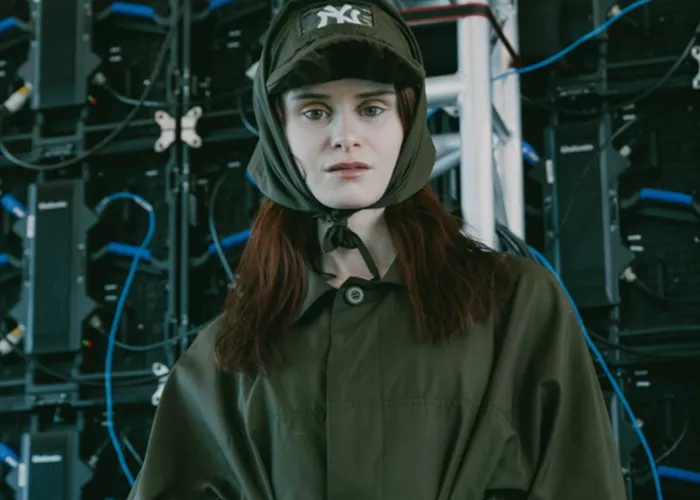Los Angeles Fashion Week offered a look into the future of fashion with Tribute Brand’s innovative UNIFORMA collection, blending physical and digital designs to explore the intersection of the two realities. The event, held at W Hollywood in November, featured models showcasing real-world garments alongside augmented reality (AR) representations of digital looks, offering a seamless fusion of both worlds.
The show featured live models lounging around a runway, while AR projections on screens around the rooftop space brought the digital garments to life. This immersive experience showcased Tribute Brand’s vision of fashion’s future: physical clothes should be “slow, functional, and zero-waste,” while digital creations should be “fast and fantastical.”
Sustainable Fashion Meets Digital Innovation
Tribute Brand’s physical collection was built on sustainability and utility, sourcing materials and patterns from Croatian factories. The designs are simple, functional, and intended for long-term wear, avoiding fleeting trends. Notable pieces included a layered bodysuit with the word “Enigma” printed on it, as well as monochromatic trench coats, zip-up jackets, and rubber shoes—all of which could be styled interchangeably for everyday wear.
Meanwhile, the brand’s digital designs unleashed a wave of creativity with no limitations. Paying subtle homage to Los Angeles culture, the virtual pieces featured striking concepts like a gown made entirely of floating dollar bills and a makeup blender-inspired dress. One virtual model appeared with a cigarette burn through its torso, while a t-shirt-only look bore the bold message “I <3 Gossip.” Camo prints also made an appearance in the digital world.
A Conversation with Tribute Brand Founders
Gala Marija Vrbanic and Tomislav Mostecak, the founders of Tribute Brand, shared their thoughts on the collection with PAPER.
Why introduce physical garments after starting with digital designs?
Vrbanic: “Fashion is a tool for self-expression, and in 2024, that expression spans both digital and physical realms. Tribute Brand has always been about embracing both worlds. While we’ve focused on digital designs, we’ve done physical projects before. UNIFORMA is special because it clearly represents our belief that physical fashion should be slow, functional, and zero-waste, while digital fashion should be fast and full of imagination.”
How do physical and digital fashion relate?
Vrbanic: “We view the two as complementary. Our digital clothes are not just copies of physical ones; sometimes they reflect the same ideas in a different form, like with PUNK, and sometimes they explore new creative directions, like in UNIFORMA. The future will likely see digital fashion become more prevalent, but for now, both exist side by side. The LAFW presentation was a perfect example of this coexistence.”
Mostecak: “Both physical and digital fashion allow for self-expression in different realities. While traditional fashion focuses on physical appearance, digital fashion offers creative freedom and acts as a marketing tool for us.”
How does Tribute Brand address the issue of overproduction in fashion?
Vrbanic: “In response to overproduction, we source existing fabrics, avoiding trends and focusing on functionality. We partnered with three Croatian factories known for their utility clothing, using their archives, deadstock fabric, and existing designs to create UNIFORMA. This way, we aren’t adding to the global waste but are instead reworking and reinterpreting existing materials.”
Mostecak: “We wanted to collaborate with factories we’ve known for years, where we already had a deep understanding of their products. By revisiting and improving familiar items, we not only preserve heritage but also ensure that these garments remain relevant and functional for today’s needs.”
How were materials sourced to meet both design goals and ethical standards?
Mostecak: “We worked with existing patterns and templates from the factories, integrating them into our design process. While there were limitations, these constraints helped drive creativity. We avoided the common practice of appropriating workwear for luxury fashion, instead ensuring authenticity while maintaining a realistic price point.”
How did the designs reflect Tribute Brand’s aesthetic?
Mostecak: “The designs were guided by the capabilities of the factories. The goal was to create a functional wardrobe that meets everyday needs. Aesthetically, the UNIFORMA collection differs from our digital designs, as physical garments must balance style and practicality. For instance, a digital dress can defy physics, but in the physical world, clothing must fit practical concerns, like being compact enough to fit into a bag.”
How did the LAFW show integrate physical and digital elements?
Vrbanic: “We wanted to showcase how the digital and physical worlds can coexist. For this, we partnered with STYPE, a leader in motion capture technology. The show featured 10 models wearing physical pieces in front of a 14-foot LED screen, which acted as a portal between the two realms. While guests first saw only the physical runway and LED portal, they soon discovered digital designs coming to life in augmented reality on surrounding screens. This seamless interaction showed how the two worlds could merge.”
Was LA culture an inspiration for the designs?
Vrbanic: “We chose LA for its openness to new ideas and its role in the fashion system we aim to change. LA embodies a unique culture of aspiration, where people chase dreams, buy into fantasies, and sell their visions. We wanted to reflect this mindset, while also highlighting how digital fashion allows for limitless expression.”
Tribute Brand’s UNIFORMA collection at LAFW demonstrated the evolving relationship between physical and digital fashion, offering a glimpse into how these realms might coexist in the future.
Related topics:
- Roshumba Williams Honors Jule Campbell: The Visionary Who Revolutionized the Fashion World
- “Jeremy Allen White Stuns in Calvin Klein, Plus Sabrina Carpenter’s Exciting Netflix Special!
- Alexa Chung and Londoners Embrace This Winter’s Chicest Cardigan Trend

